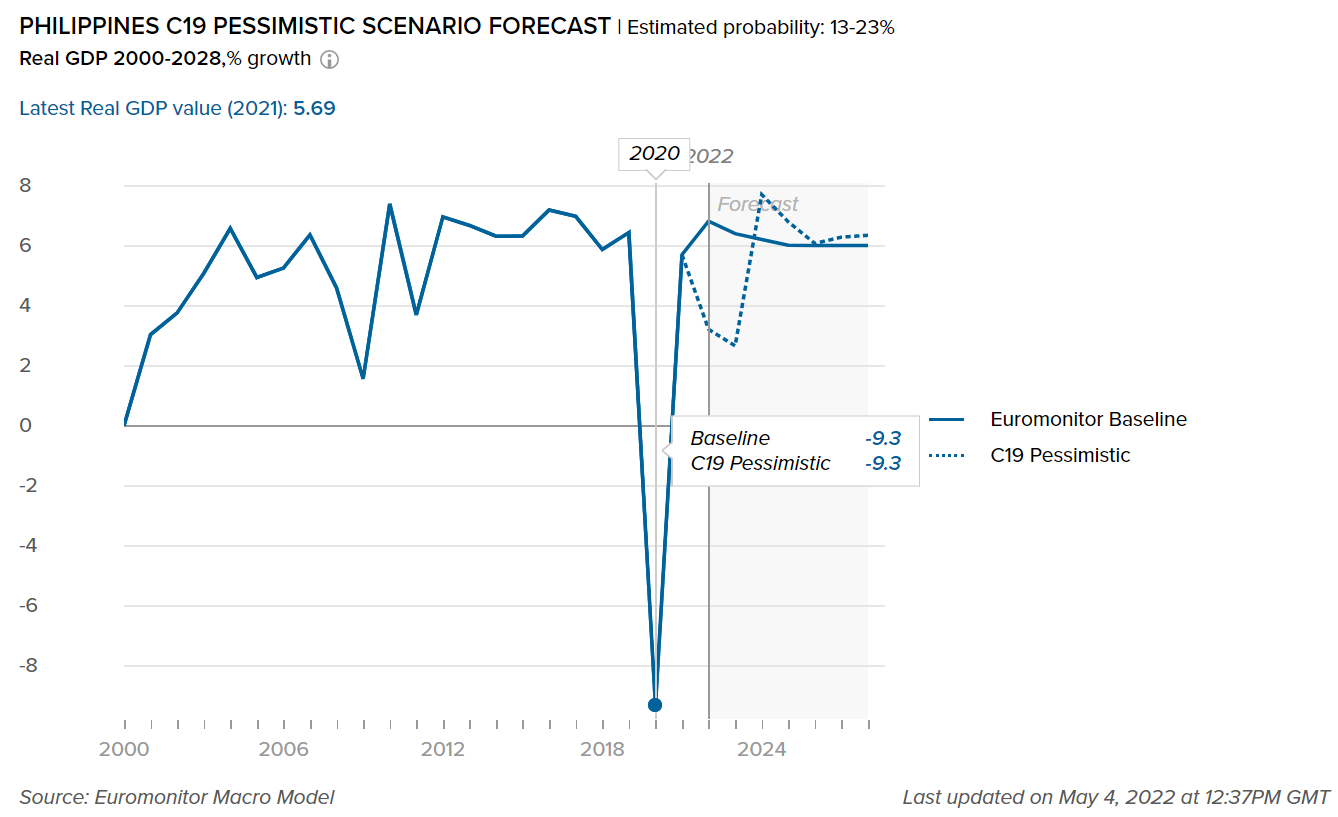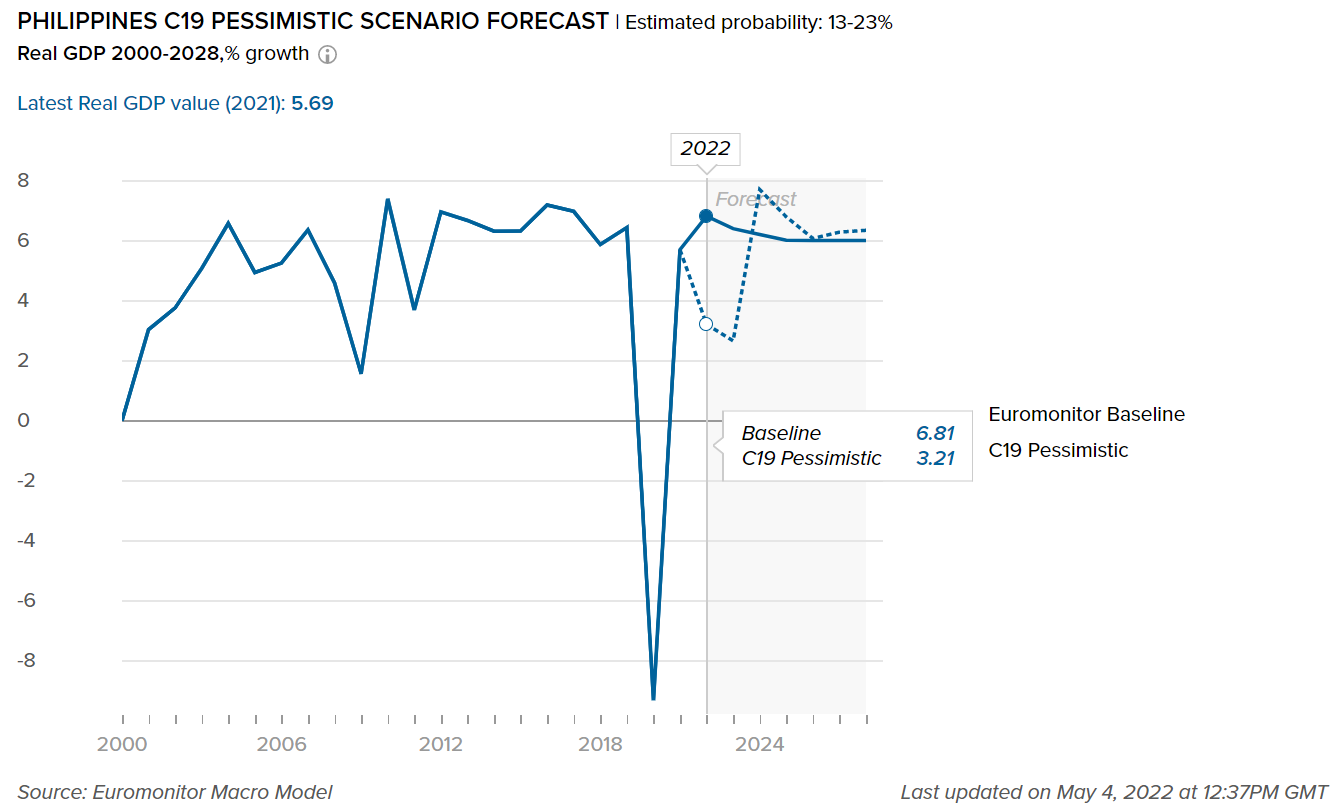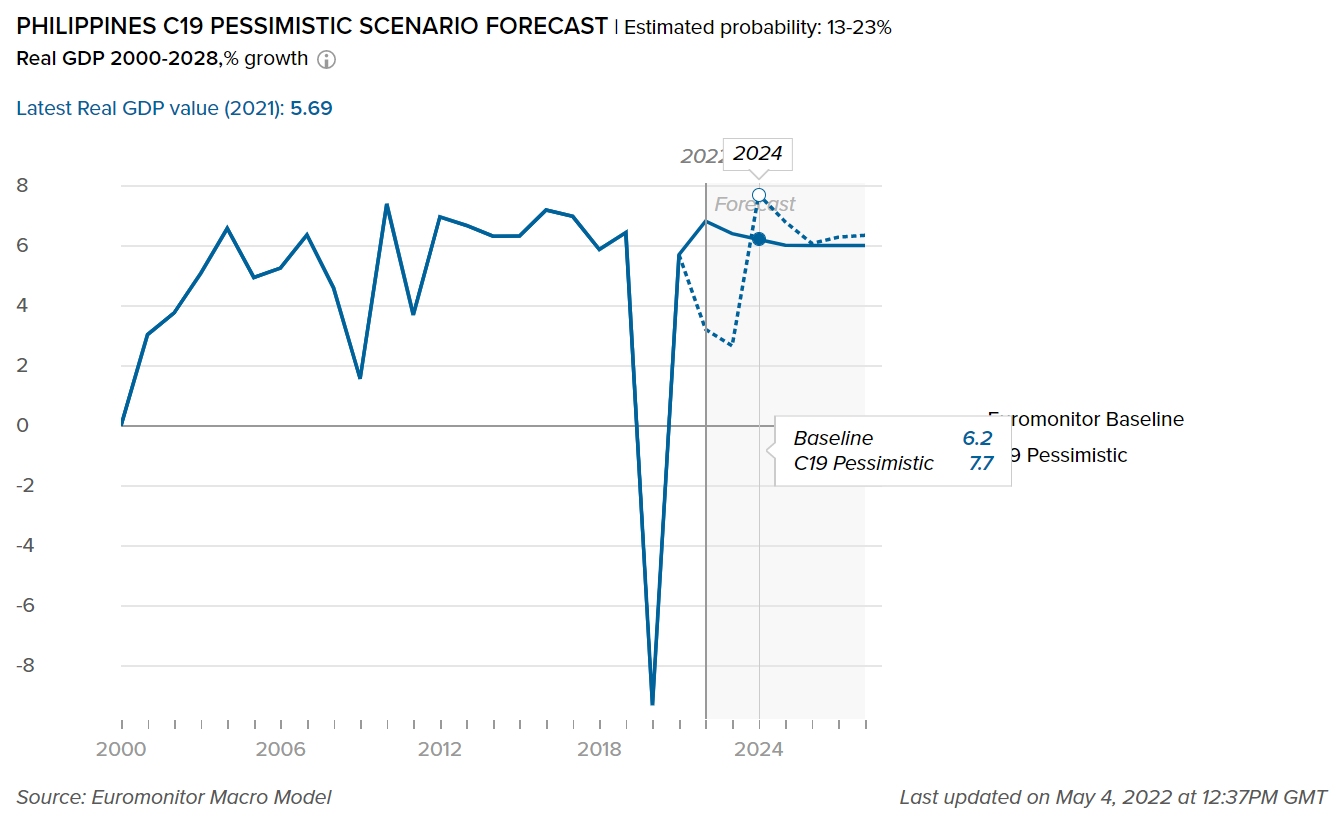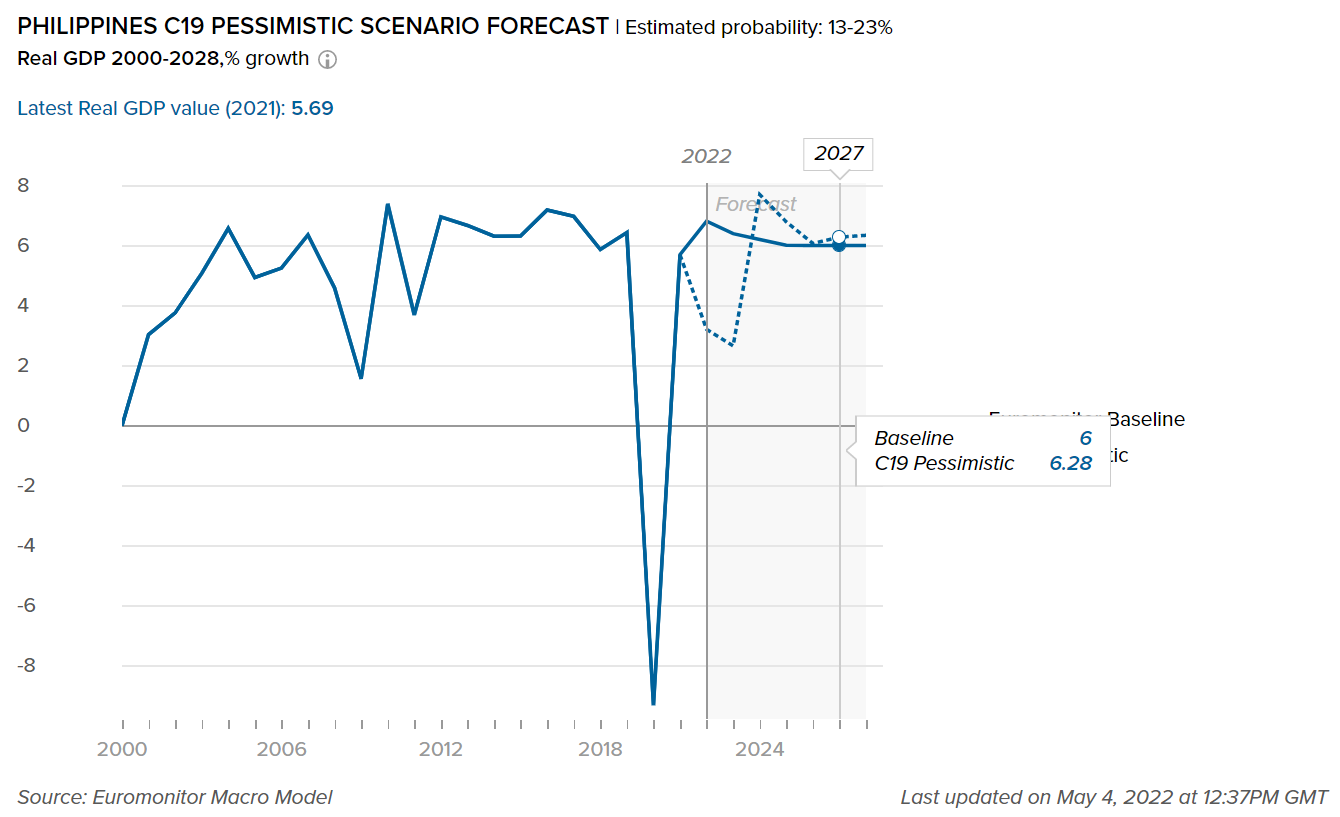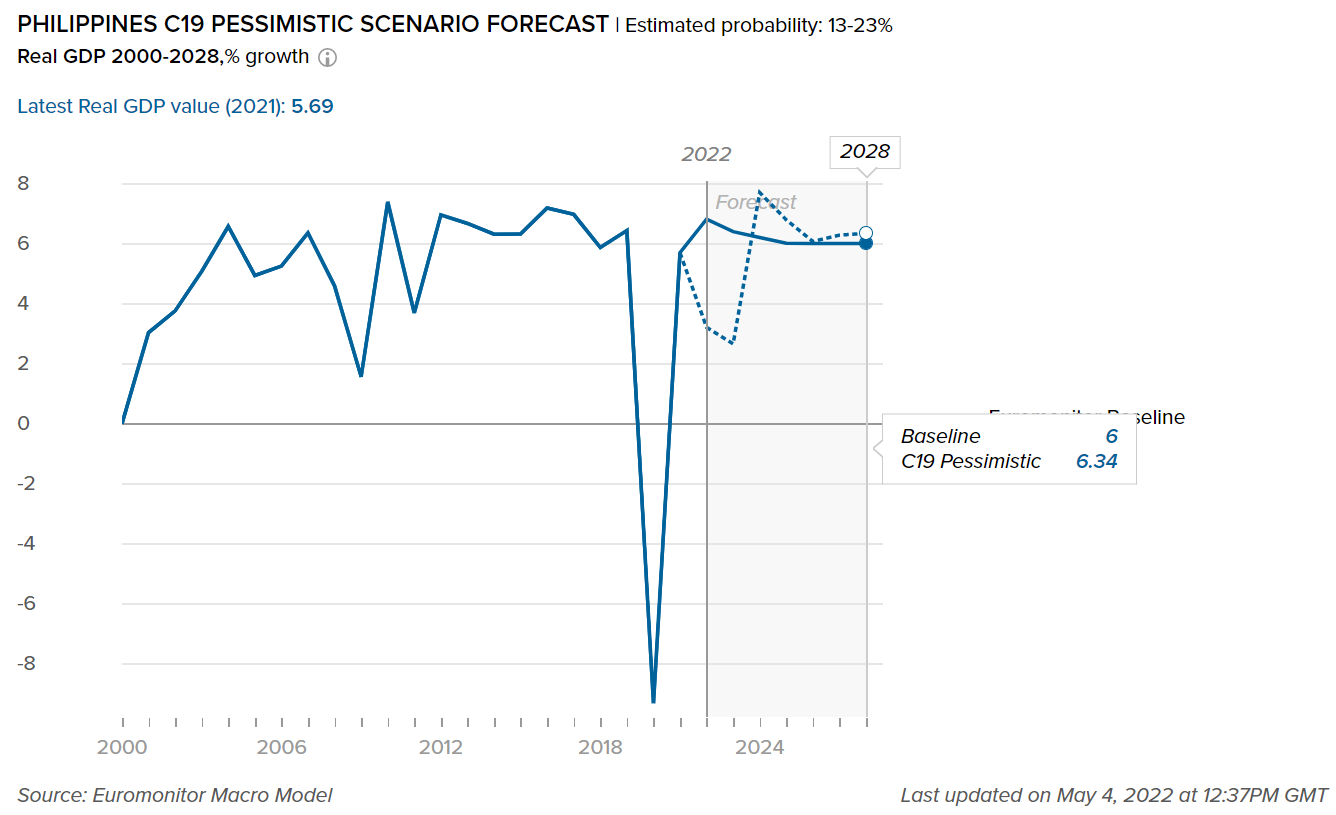Overview
- Packaging Overview
-
2020 Total Packaging Market Size (million units):
64,533
2015-20 Total Packaging Historic CAGR:
3.5%
2021-25 Total Packaging Forecast CAGR:
1.5%
Packaging Industry
2020 Market Size (million units)
Beverages Packaging
27,034
Food Packaging
27,409
Beauty and Personal Care Packaging
4,831
Dog and Cat Food Packaging
26
Home Care Packaging
5,234
Packaging Type
2020 Market Size (million units)
Rigid Plastic
13,090
Flexible Packaging
35,985
Metal
3,809
Paper-based Containers
1,954
Glass
9,214
Liquid Cartons
469
- Key Trends
-
COVID-19 induced lockdowns and reduced economic activities are putting pressure on the already struggling Philippines’ economy, which is in recession. Therefore, large pack types in packaged foods and beverages, which provide better per unit value and convenience in terms of transportation are expected to perform well. Flexible packaging such as plastic pouches and PET bottles which are light and have re-sealable properties are expected to dominate the packaging market.
- Packaging Legislation
-
Various laws have been passed to manage waste, but implementation remains the issue. This is why the Philippines stands among the top plastic polluters in the world, and the use of plastic bags has reached extremely high levels. In February 2020, the government announced the ban on single-use plastic in government offices, which was extended beyond government offices to the entire country in the latter half of 2020. If implemented as planned, this bill could help the country manage its plastic pollution more efficiently.
- Recycling and the Environment
-
It is estimated that 20% of plastic waste ends up in the oceans, causing pollution and clogging the waterways of metro Manila. So, along with the government, some big companies like Coca-Cola are doing their part to improve the situation. In September 2020, Coca-Cola Philippines joined forces with Plastic Bank, a social enterprise focused on eliminating ocean plastic, to collect 100,000 kg of ocean-bound plastic over 2021. Coke plans to use the recovered plastic in its recycled PET facility to produce recycled packaging.
- Packaging Design and Labelling
-
Packaging designs and aesthetics are used by companies as a differentiating factor to stand out from their competitors, especially in the home care and alcoholic drinks segments. For example, Johnnie Walker Pocket Scotch came up with a new pack design that looks sleeker and more appealing to the younger generation of adult drinkers than the old 200ml format. In the home care segment, Cusina launched its dishwashing products in different colors which coordinate with the scented ingredients used to better gain customers’ attention.
Click here for further detailed macroconomic analysis from Euromonitor
- Definitions
-
- Beauty and Personal Care Packaging: This is the aggregation of packaging for baby care, bath & shower products, deodorants, hair care, color cosmetics, men's grooming products, oral hygiene, perfumes & fragrances, skincare, depilatories, and sun care. Black market sales and travel retail are excluded.
- Dog and Cat Food Packaging: This is the aggregation of dog and cat food packaging.
- Packaged Food Packaging: This is the aggregation of packaging for baby food, Bakery, canned/preserved beans, canned/preserved fish/seafood, canned/preserved fruit, canned/preserved meat and meat products, canned/preserved tomatoes, canned/preserved vegetables, other canned/preserved food, confectionery, chilled fish/seafood, chilled lunch kit, chilled processed meats, fresh cut fruits, dairy, dessert mixes, rice, frozen bakery, frozen desserts, frozen meat substitutes, frozen processed fish/seafood, frozen processed potatoes, frozen processed poultry, frozen processed red meat, frozen processed vegetables, other frozen processed food, ice cream, meal replacement, noodles, oils and fats, pasta, ready meals, sauces, dressings and condiments, snack bars, soup, spreads and sweet and savory snacks.
- Home Care Packaging: This is the aggregation of packaging for laundry care, dishwashing products, surface care, chlorine bleach, toilet care, polishes, air fresheners, and insecticides.
- Beverages Packaging: Beverage packaging is the aggregation of alcoholic drinks packaging, hot drinks packaging, and soft drinks packaging.
Beverages
- Overview
-

- Flexible Packaging Landscape
-

- Thanks to the popularity of flexible aluminum/plastic in instant coffee, tea, and flavored powder drinks, the pack type retained its dominance in hot drinks packaging with a volume share of over 97.0% and volume growth of 6.2% in 2020.
- The share of flexible plastic packaging in soft drinks came down from 13.2% in 2019 to 11.8% in 2020. This was primarily due to the rise in popularity of rigid plastic packaging like thin-walled plastic containers and PET bottles. These pack types help maintain the pressure of the air inside the bottle/container, keeping the taste of soft drinks fresh.
- Trends
-
- There is a rising trend to order through e-commerce websites as the threat of the pandemic persists. As a result, pack types that are less breakable and safer for transportation, like rigid plastic, grew. This led to a decline in glass bottles by 8.9% in volume terms in 2020.
- There is a rising concern among coffee consumers about the packaging of coffee pods. They feel that the packaging is wasteful and contributing to plastic pollution. Responding to this trend, major coffee pods players have taken steps to improve their environmentally consciousness credentials, like Nespresso introducing recyclable coffee pods made from 80% recycled aluminum.
- Outlook
-
- There is a rising influence of western culture in the Philippines, due to the deeper penetration of social media. Young adults of the legal drinking age, which comprises a large portion of the population, are becoming more open to trying new products and experiences. This has led to increased awareness about a variety of products, including wine. This will help boost the sales of glass bottles, the only pack type of wine in the Philippines, which is expected to grow at a CAGR of 2.8% in volume terms over 2021-25.
- Price sensitivity among soft drink consumers is expected to continue over 2021-25 as economic uncertainty due to COVID-19 is expected to persist. Multipacks and larger packs, which provide better price per unit, are expected to perform well in this category. 1,000ml and 1,500ml PET bottles are expected to grow at a CAGR of 6.8% and 4.6% respectively in volume terms over 2021-25.
Click here for more detailed information from Euromonitor on the Beverages Packaging industry
Dog and Cat Food
- Overview
-
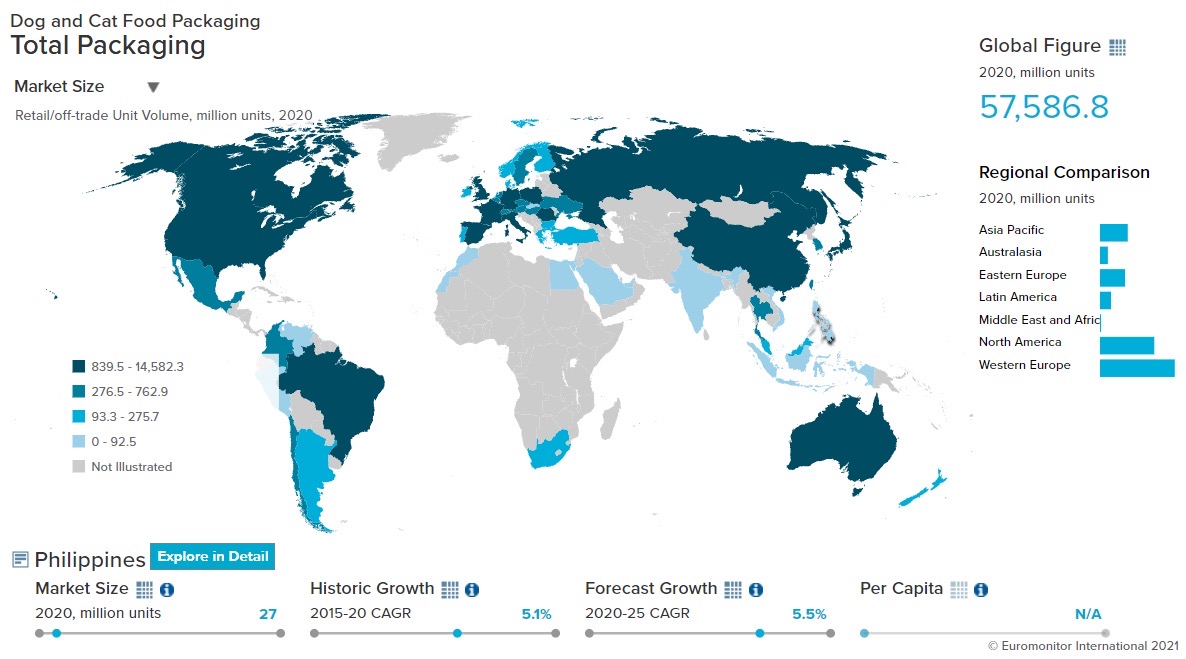
- Flexible Packaging Landscape
-

- COVID-19 induced economic uncertainty has forced people to restrict their spending. This trend can be seen in dog food as well. Since dry dog food is more affordable than wet, it has shown a stronger volume growth of 8.4%, while wet dog food only grew 2.7% in 2019. As a result, flexible plastic packaging, which is suitable for storing dry food, showed a volume growth of 8.0% in dog food packaging in 2020.
- Trends
-
- Pet food continues to be increasingly packed in small, single-serve pack sizes, due to which flexible pack types, such as plastic pouches, primarily come without closures. Even the big pack sizes of economical brands come without closures because these brands sometimes distribute the product to retailers, which sells it by weight to the pet owners.
- To ensure that cat food remains fresh and free from contaminants, various brands are coming up with new pack types. For example, Cuties Catz, an economy dry cat food brand, introduced secondary packaging for its 22Kg pack type. The package now contains 22 packets of 1Kg packs. This helps the product to be sold as 1kg packaged products rather than unpackaged, which helps keep food fresh.
- Outlook
-
- The demand for pet food is expected to rise as more owners are becoming aware of specific nutritional requirements for their pets, and how those requirements can be fulfilled by packaged foods. As a result, an increase in the dog and cat food market is expected to contribute to subsequent growth in its packaging at a CAGR of 5.5% in terms of volume over 2021-25.
- The shift from metal packaging to flexible packaging is expected to continue as manufacturers attempt to attract consumers with new and innovative designs, which flexible packaging is best suited for. Pack types like flexible plastic are expected to show strong growth of CAGR 9.5% in volume over 2021-25.
Click here for more detailed information from Euromonitor on the Dog and Cat food Packaging industry
Beauty and Personal Care
- Overview
-

- Flexible Packaging Landscape
-
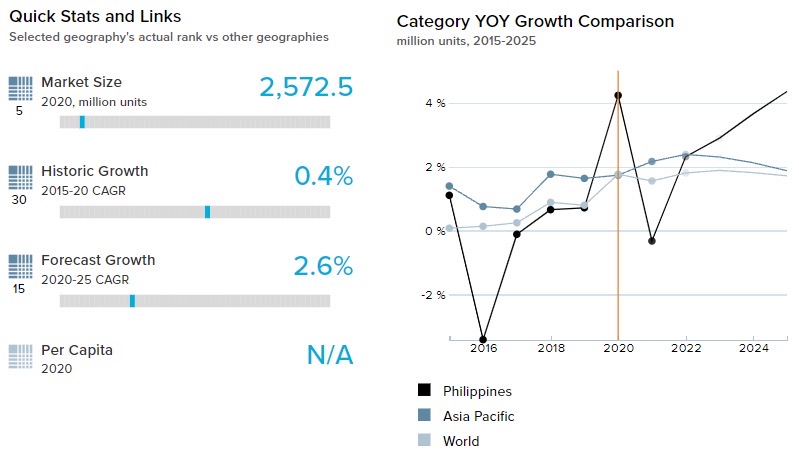
- Flexible packaging continues to be the leading pack type in 2020 with a volume share of 53.2%. This is primarily due to the strong growth of hair care packaging, which showed a volume growth of 6.4% in 2020.
- Due to COVID-19, there is an increased focus on personal hygiene. As a result, oral care and bath/showering products grew in demand. Their main pack type, flexible plastic, showed strong volume growth of 3.4% and 4.3% respectively in 2020.
- Trends
-
- COVID-19 induced lockdown restrictions and working from home has limited social gatherings. This coupled with economic uncertainty due to the pandemic has prompted people to prioritize their spending on essential goods. This trend is expected to continue until the pandemic persists. As a result, due to its non-essential nature, color cosmetics registered the highest decline during the year within beauty and personal care products. Rigid plastic, which is the main pack type of this segment, showed a volume decline of 20.1% in 2020.
- Squeezable plastic tubes showed a strong volume growth of 4.2% in 2020, backed by strong demand for hand cream. The demand was brought on by an increased focus on regularly washing one's hands with anti-bacterial products, due to the pandemic, which caused dryness.
- Outlook
-
- Water-based products are extremely popular in the Philippines, partly due to the country’s humid climate, and this popularity is expected to increase over 2021-25. Pack types that are suitable for water-based products and provide the convenience of storing are likely to have strong demand. As a result, rigid plastic and flexible plastic in beauty and personal care packaging are expected to show volume growth at a CAGR of 3.9% and 2.6% respectively over 2021-25.
- The sub-categories of beauty and personal care packaging products, which declined during 2020 due to pandemic, are expected to bounce back strongly as restrictions are expected to ease over 2021-25. As a result, color cosmetics packaging and fragrance packaging are expected to grow at a volume CAGR of 8.6% and 8.4% respectively over 2021-25.
Home Care
- Overview
-

- Flexible Packaging Landscape
-
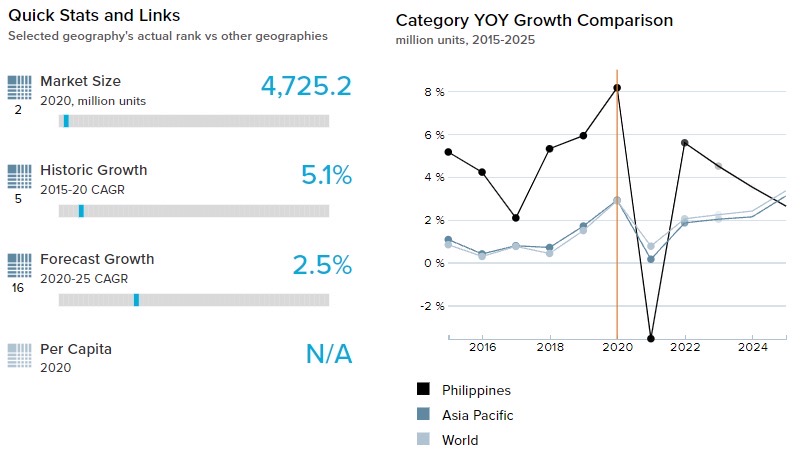
- Due to the COVID-19 induced fear of stockouts and economic uncertainty, large pack types in the home care segment benefitted the most. 1,000g and 1,500g flexible plastic pack sizes showed a phenomenal volume growth of 28.7% and 40.4% in 2020.
- On the back of increased usage of e-commerce websites for ordering products, pack types that are suitable for transportation, like plastic pouches, showed growth. In addition, plastic pouches also benefitted from being the most popular for refillable bags, which are also in demand because of their low price. Ease of transport and affordability led plastic pouches to see volume growth of 11.9% in home care packaging in 2020.
- Trends
-
- COVID-19 induced restrictions and safety protocols forced people to consume more food at home. As a result, there was a boost in the sales of dishwashing products. One of the popular pack types in the category, thin-walled plastic containers, showed a volume growth of 17.1% in 2020.
- Flexible packaging continued to dominate in laundry packaging, with a volume share of 99.5%. In the wake of COVID-19, there is a trend to keep clothes and the nearby surroundings more hygienic, which boosted the demand for laundry products. As a result, flexible packaging formats recorded a volume growth of 7.8% in 2020.
- Outlook
-
- Home care companies are trying to push refillable and recyclable formats to meet the sustainability concerns in the country. As a result, flexible plastic pouches and HDPE bottles, which can be recycled, are expected to grow at a volume CAGR of 6.5% and 4.0% respectively over 2021-25.
- Many companies are coming up with innovative solutions to spread awareness around the concept of post-consumption recycling. For example, eco-friendly hand dishwashing brand Cusina comes in recyclable PET bottles, with a message on the front label asking consumers to recycle the bottle after use. As a result, such PET bottles, which can be recycled post-consumption, are expected to grow at a CAGR of 4.0% in volume terms over 2021-25.
Click here for more detailed information from Euromonitor on the Home Care Packaging industry
Packaged Food
- Overview
-
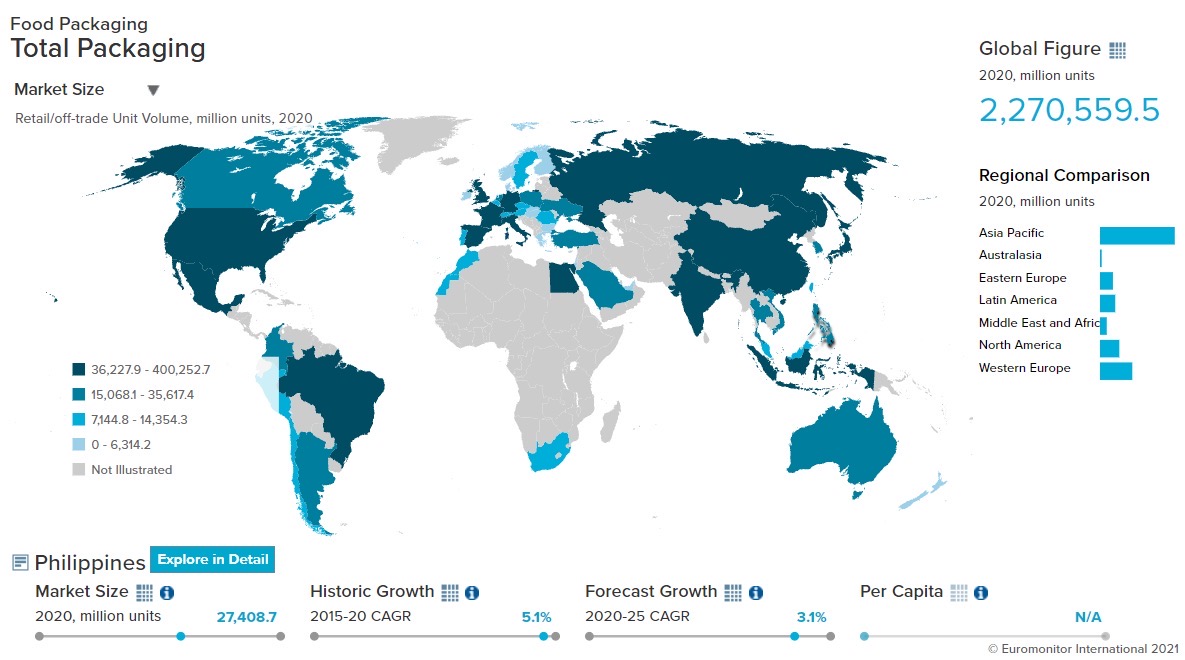
- Flexible Packaging Landscape
-

- The demand for all types of fresh and packaged food that can be used to prepare meals and snacks grew as people were forced to make food at home due to the threat of COVID-19. Cheese was a product that benefited from this, and saw sales increase in 2020, as it can be readily used to prepare meals and snacks. Flexible packaging, with a 54.6% volume share, continued to lead cheese packaging and showed a volume growth of 5.7% in 2020.
- Processed meat saw a boost in its sales as it has a longer shelf life than fresh meat and thus reduced the need for frequent trips outside. As a result, flexible plastic packaging, which is lighter than metal cans and can help retain a similar level of product freshness, saw volume growth of 9.5% in processed meat packaging in 2020.
- Trends
-
- There is an increasing focus on maintaining good health and a strong immune system in the wake of COVID-19. This led to increased sales of milk and milk alternatives, especially soy milk, owing to its health benefits like boosting immunity. As a result, its main pack type, brick liquid cartons, had a volume share of 44.7%, showed a volume growth of 9.2% in 2020.
- The number of women joining the workforce is on the rise in the country. This trend is boosting the demand for milk formula as it helps working mothers save time. Therefore, metal tins, which are perceived to be best suited for food safety and security, grew at a CAGR of 2.7% in volume terms over 2015-20.
- Outlook
-
- Flexible packaging, which dominated confectionery packaging with a volume share of 94.8% in 2020, is expected to remain dominant over 2021-25 and is likely to grow a CAGR of 2.5% in volume terms. The popularity of flexible packaging like flexible aluminum/plastic is because of its low price point and practicality, as it can be used for both primary and secondary packaging.
- Ready meals, especially frozen ready meals, are expected to show strong growth over 2021-25. This is primarily because frozen ready meals can be prepared very easily and help save time, which is an important consideration for busy consumers. As a result, popular pack types of ready meals such as flexible plastic and thin wall containers are expected to show a volume CAGR of 7.5% and 5.3% over 2021-25.
Click here for more detailed information from Euromonitor on the Packaged Food Packaging industry
RECOVERY FROM COVID
- Overview of COVID-19 conditions in Philippines
-

The Philippines government is not likely to remove the alert status until Q3 of 2022
- According to the World Health Organization (WHO), as of May 2022, the Philippines had 3,688,750 confirmed COVID-19 cases, with 60,455 deaths, and 245 new cases.
- On May 19, 2022, the total number of vaccinations in the Philippines reached 149,025,442. The share of the fully vaccinated population was 63.4%, with 12.6% of Filipinos having received booster doses.
- As per the Inter-Agency Task Force, effective May 30, 2022, adult passengers (aged 18 or above) entering the Philippines, will no longer be required to provide a pre-departure COVID-19 negative test report (RT-PCR or Rapid Antigen Test). However, they will have to be fully vaccinated and have at least one booster shot before entering the Philippines. If they do not get the booster dose before entering the country, they will have to provide a negative RT-PCR test result taken 48 hours before departure, or a rapid antigen test result taken 24 hours prior to departure. Travelers between the ages of 12-17 do not need to show any negative test results, provided they are fully vaccinated and have the certificate. Lastly, travelers under age 12 will be exempted from pre-departure COVID-19 measures if their parents are fully vaccinated.
The chart below shows Euromonitor International’s Recovery Index.
The quarterly reported Recovery Index is a composite index that provides a quick overview of economic and consumer activity. It keeps track of the latest quarterly economic/consumer data and forecasts in key economies to gauge when economic activity and consumer demand are likely to return to the pre-pandemic levels of 2019.
A score of 100 and over indicates a full recovery in which economic output, the labor market, and consumer spending all return to/exceed 2019 levels.
Detailed methodology is provided in the Appendix.Quarterly Recovery Index and Related Indicators, Philippines
Quarterly Recovery Index is currently unavailable for the Philippines.
- Impact on GDP
-
This graph shows our “most probable” and “worst case” scenarios of how COVID-19 will impact real GDP value in the Philippines. Our “most probable” or Baseline scenario has an estimated probability of 45-60% over a one-year horizon. Our “worst case” or Pessimistic scenario has an estimated probability of 13-23% over a one-year horizon. For more details, please refer to the detailed explanation of the COVID-19 scenarios in the Scenario Definitions section.
Please note that the forecasts will be adjusted every three months, according to the expected number of cases, recoveries, and deaths due to COVID-19 in this country, as well as shifting socioeconomic conditions (the most recent update was May 2022).
Baseline forecast refers to the “best case” COVID-19 scenario forecast that has an estimated probability of 45-60%.
C19 Pessimistic refers to the “worst case” COVID-19 scenario forecast that has an estimated probability of 13-23%.
GDP is predicted to grow as economic uncertainty subsides over 2022-2026
- In 2020, the Philippines recorded a massive contraction of 9.3% owing to the COVID-19 pandemic. The country experienced significant declines in consumption and investment growth, as well as a sharp slowdown in exports, tourism, and remittance inflows. In addition, consumer and business confidence dropped due to containment measures, elevated uncertainty, and lower household incomes. However, the economy bounced back in 2021, supported by economic stimulus measures, recovering global demand, and the gradual lifting of coronavirus curbs. This momentum is expected to help the country’s economy to grow by 6.8% and achieve upper-middle-income country status by late 2022, as per the Philippine Statistics Authority. The economy is expected to remain one of the most dynamic in the Asia Pacific region over 2022-2026.
- Over 2019-2021, the government proposed a series of reforms to boost foreign direct investment (FDI) inflows. For example, the Philippines government relaxed the local employment requirements for foreign investors and plans to reduce corporate income tax from 30.0% to 20.0% over the next 10 years. In addition, the country also allowed 100.0% foreign ownership in large-scale geothermal projects such as Tongonan Geothermal Project and MakBan Geothermal Project. However, despite the progress, barriers such as high transaction costs, currency volatility, and liquidity risks to foreign investment remain in the country. As a result, the country’s FDI inflow is expected to lag behind the Asia Pacific average.
- Impact to Sector Growth
-
Please note that the forecasts are adjusted every three months according to the expected number of cases, recoveries, and deaths due to COVID-19 in the country, as well as shifting socioeconomic conditions.
The graph below shows the adjusted forecasts of the percentage growth for the categories mentioned, highlighting the impact of COVID-19 between our pre-COVID-19 estimates and the “most probable” (Baseline) forecast, which has an estimated probability of 45-60%.

Baseline forecast refers to the “best case” COVID-19 scenario forecast that has an estimated probability of 45-60%.
Snacks, cooking ingredients, and meals are set to witness a strong rebound as foodservice outlets reopen
- With the outbreak of COVID-19, snacks declined as foodservice outlets, restaurants, pubs, and other eating facilities were closed in 2020. Moreover, restricted spending from Filipinos also added to this decline. However, as restrictions eased and the country rolled out its vaccination program, snacks saw stronger growth in 2021. In addition, businesses returned to relative normalcy, and tourism and foodservice resumed. As a result, products associated with indulgences such as ice cream, chocolate confectionery, and sweet biscuits registered the quickest recovery, as they fulfilled the need for comfort food. Over 2022-2026, snacks are likely to witness significant growth, spurred by new product development and innovation.
- Cooking ingredients and meals are expected to record a significant CAGR of 7.0% over 2022-2026, which will be driven by the preference for a homebound lifestyle among Filipinos. Despite the reopening of outside eateries, Filipinos are predicted to feel less comfortable going out as often as they used to during pre-pandemic conditions, owing to the fear of contracting the virus. With in-home lifestyles set to linger, products used for at-home meal preparations such as spices, herbs, pulses, meat, and cereals are set to benefit, with frozen ready meals predicted to be in heavy demand over 2022-2026 owing to the long line of product options.
Please note that the forecasts are adjusted every three months according to the expected number of cases, recoveries, and deaths due to COVID-19 in the country, as well as shifting socioeconomic conditions.
This graph shows our “most probable” and “worst case” estimate scenarios of how COVID-19 will impact the percentage growth for the sectors covered in the Philippines. Our “most probable,” or Baseline scenario, has an estimated probability of 45-60% over a one-year horizon. Our “worst case,” or Pessimistic scenario, has an estimated probability of 13-23% over a one-year horizon.

Baseline forecast refers to the “best case” COVID-19 scenario forecast that has an estimated probability of 45-60%.
C19 Pessimistic refers to the “worst case” COVID-19 scenario forecast that has an estimated probability of 13-23%.
Revival of social activities is set to improve the beauty and personal care market in the Philippines
- Over 2022-2026, beauty and personal care is expected to improve owing to the revival of social and economic activity. The reopening of offices and other public places are likely to encourage consumers to focus more on personal grooming. This will support renewed demand for subcategories such as color cosmetics, sun care, deodorants, and fragrances. However, the pandemic-induced economic impact and high inflation may impact consumer purchasing power. This heightened budget-consciousness is set to support demand for homegrown brands such as Silka, Bambini, and Hairworks, which offer similar benefits to premium brands but at mass-market prices.
- In dairy products and alternatives, shelf stable milk, cheese, and yogurt are expected to record the most favorable value sales growth rates over 2022-2026, owing to the newfound focus on home consumption. After the outbreak of the pandemic in 2020, many Filipinos started having breakfast at home rather than in a café or on their way to work. With shelf stable milk, cheese, and yogurt all considered to be ideal breakfast options, these categories are predicted to benefit substantially. In addition, drinking yogurt is expected to witness significant growth, owing to the health benefits such as strong immunity and improved metabolic and digestive function, that it provides.
- Impact on Flexible Packaging
-
The following tables display adjusted market size for 2021, market size forecasts for 2022, and the percentage difference between the February 2022 and June 2022 estimates for the year 2022.
Please note that for the current quarterly update, the following table covers beauty and personal care packaging and home care packaging industries only.
Packaging Industry
2021 market size as per Jun 2022 data
2022 market size as per Jun 2022 data
% Difference between Jun 22 and Feb 22 data for 2022
Beauty and Personal Care Packaging
4,707
4,824
-2.4
Home Care Packaging
5,250
5,449
1.6
Packaging Type
2021 market size as per Jun 2022 data
2022 market size as per Jun 2022 data
% Difference between Jun 22 and Feb 22 data for 2022
Rigid Plastic
12,983
13,628
-0.37
Flexible Packaging
36,258
37,533
0.01
Metal
4,130
4,171
-0.08
Paper-based Containers
2,029
2,084
1.11
Glass
9,050
9,083
0.00
Liquid Cartons
910
957
0.00
Consumers look for less expensive packaging options as limitations on spending continue
- Within home care packaging, plastic pouches and HDPE bottles were among the most popular pack types, with flexible plastic packaging the dominant pack type over 2020-2021. The popularity of plastic pouches as refill packs aided its growth, whereas HDPE bottles were in demand owing to their availability in larger sizes. As Filipinos were stockpiling home care products such as surface cleaners, dishwashers, and detergents to maintain continuity of supply in their home, as well as avoid frequent shopping trips, larger pack sizes became the most preferred pack type. In addition, the larger HDPE bottles also tend to offer better prices per liter than smaller pack types.
- Less expensive packaging options like flexible aluminum/plastic, flexible plastic, or folding cartons for hot drinks generally have been growing in the Philippines over the past few years and are expected to see further growth over 2022-2026. Contrary to this, expensive pack types like glass jars and PET jars are expected to see declines as consumers continue to be price-conscious. In addition, leading players in hot drinks are set to continue to focus on flexible packaging as a means of differentiation, highlighting indulgent flavors, and high quality. For example, Universal Robina Corp launched Great Taste Vanilla Cream and Great Taste White Crema, with packaging claims such as “creamy linamnam” (“creamy flavor”) and “sweet linamnam” (“sweet flavor”).
- The increasing variety of pack sizes is becoming available in alcoholic drinks highlighting the continual engagement of manufacturers with consumers. Moreover, the demand for sake made the variety of pack sizes even more fragmented in wine. As compared to light grape wine and sparkling wine, which are dominated by the 750ml pack size, soju has 300ml, 750ml, 1,800ml, and other pack sizes.
- Similarly, in beer, AB Heineken’s recently launched Tiger Black, is available in 500ml metal beverage cans as well as 330ml, 500ml, and 1-liter glass bottles. This variety of pack sizes is set to have a positive impact on very price-conscious consumers. Hence, brands will be encouraged to either launch products in smaller pack sizes to reduce the necessary cash outlay or introduce larger-than-standard sizes to offer better value for money in terms of price per liter. It will contribute to a greater variety of pack sizes.
- Definitions
-
- Beauty and Personal Care Packaging: This is the aggregation of packaging for baby care, bath & shower products, deodorants, hair care, color cosmetics, men's grooming products, oral hygiene, perfumes & fragrances, skin care, depilatories and sun care. Black market sales and travel retail are excluded.
- Dog and Cat Food Packaging: This is the aggregation of dog and cat food packaging.
- Packaged Food Packaging: This is the aggregation of packaging for baby food, Bakery, canned/preserved beans, canned/preserved fish/seafood, canned/preserved fruit, canned/preserved meat and meat products, canned/preserved tomatoes, canned/preserved vegetables, other canned/preserved food, confectionery, chilled fish/seafood, chilled lunch kit, chilled processed meats, fresh cut fruits, dairy, dessert mixes, rice, frozen bakery, frozen desserts, frozen meat substitutes, frozen processed fish/seafood, frozen processed potatoes, frozen processed poultry, frozen processed red meat, frozen processed vegetables, other frozen processed food, ice cream, meal replacement, noodles, oils and fats, pasta, ready meals, sauces, dressings and condiments, snack bars, soup, spreads and sweet and savory snacks
- Home care Packaging: This is the aggregation of packaging for laundry care, dishwashing products, surface care, chlorine bleach, toilet care, polishes, air fresheners and insecticides.
- Beverages Packaging: Beverage packaging is the aggregation of alcoholic drinks packaging, hot drinks packaging and soft drinks packaging.
- Scenario Definitions
-
Scenario Assumptions
Baseline
C19 Pessimistic
Estimated probability
45-60% over a one-year horizon
13-23% over a one-year horizon
Global GDP growth
2.0% to 4.0% in 2022
1.8% to 4.2% in 2023
-1.0% to 1.0% in 2022
-0.5% to 2.0% in 2023
COVID-19 situation
A combination of high vaccination rates with milder virus variants and widespread availability of antiviral drugs make COVID-19 an endemic disease in advanced economies
The spread of a more infectious and highly vaccine-resistant COVID-19 mutation requires intense lockdowns/social distancing measures in 2022-2023, delaying the economic recovery from the pandemic
Vaccinations
Existing vaccines remain highly effective against severe diseases from new coronavirus variants, with moderate vaccine modifications
Vaccination campaigns progress in developing economies is slower than expected
Impact on economy
Services activity would pick up in 2022 on the back of loosening COVID-19 restrictions and releasing pent-up demand
Longer-lasting and much stricter distancing measures cause large drops in consumption, business revenues, employment, and wages relative to the baseline forecast in 2022-2023
- Recovery Index
-
Recovery Index Methodology
Euromonitor International’s Recovery Index is a composite index that provides a quick overview of economic and consumer activity and helps businesses predict recovery in consumer demand in 48 major economies. The index takes into consideration total GDP and factors that determine consumer spending - employment, consumer spending, retail sales, and consumer confidence. Index scores measure the change relative to the average per quarter for 2019.
Category
Weighting
Focus
Economic Activity
20%
Tracks and forecasts the level of real GDP, as this is a broad measure of everything that workers and capital produce in a country.
Employment
20%
Looks at the employed population and average actual weekly working hours in each quarter, as these indicators help track households’ primary source of income besides government financial support.
Consumer Spending
25%
Looks at private final consumption expenditure in each quarter, as this is the best official measure of consumer spending in real terms.
Retail Sales
25%
Focuses on seasonally adjusted real retail sales data as a timely indicator of economic performance and strength of consumer spending.
Consumer Confidence
10%
Looks at the standardized consumer confidence index to see how consumers across countries feel about their situation and when they will start feeling better about the future.

